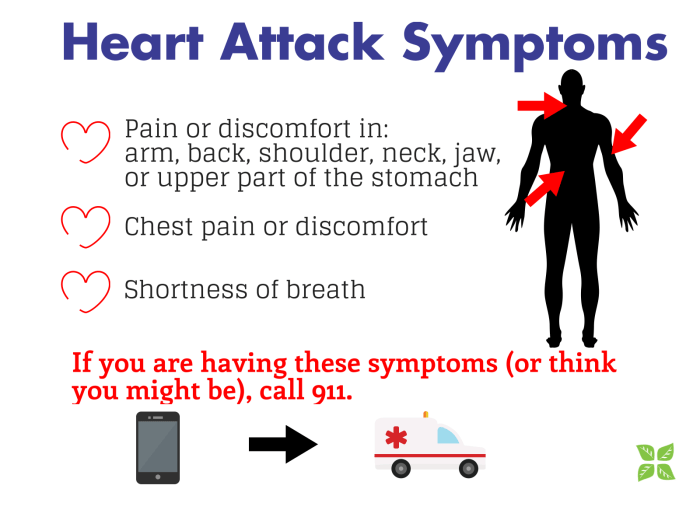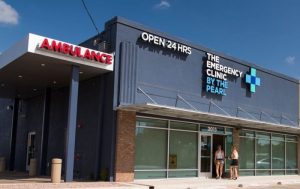
Starting with Emergency Care for Heart Attack Symptoms, this introduction aims to grab the attention of the readers with essential information presented in a clear and engaging manner.
Exploring the importance of recognizing and responding to heart attack symptoms promptly can make a significant difference in saving lives.
Overview of Heart Attacks
A heart attack, also known as a myocardial infarction, occurs when there is a blockage in the blood flow to the heart muscle, leading to damage or death of the heart tissue.
Common Symptoms of a Heart Attack
- Chest pain or discomfort, often described as pressure, squeezing, or fullness
- Pain or discomfort in other areas of the upper body, such as the arms, back, neck, jaw, or stomach
- Shortness of breath
- Cold sweats, nausea, or lightheadedness
Risk Factors for Heart Attacks
- Smoking
- High blood pressure
- High cholesterol levels
- Obesity
- Diabetes
- Lack of physical activity
- Family history of heart disease
Importance of Emergency Care

Immediate emergency care is crucial for heart attack symptoms because time is of the essence in saving heart muscle and preventing further damage. In a heart attack, the flow of blood to the heart is blocked, leading to the deprivation of oxygen-rich blood to the heart muscle. The longer the heart muscle is deprived of oxygen, the more damage it sustains.
This is where the concept of “time is muscle” comes into play, emphasizing the need for rapid intervention to restore blood flow and minimize heart muscle damage.
Role of Emergency Medical Services (EMS)
Emergency Medical Services (EMS) play a vital role in providing rapid care to individuals experiencing heart attack symptoms. EMS teams are trained to assess the situation quickly, administer necessary treatments such as oxygen therapy and medications, and transport the patient to a medical facility for further care. Their prompt response can make a significant difference in the outcome of a heart attack, potentially saving lives and preventing long-term complications.
Recognizing Heart Attack Symptoms
When it comes to recognizing heart attack symptoms, it’s crucial to be aware of the common signs that someone may be experiencing a heart attack. Additionally, atypical symptoms can also indicate a heart attack, making it important not to ignore any potential warning signs.
Common Signs of a Heart Attack
- Chest pain or discomfort, often described as pressure, squeezing, or fullness
- Pain or discomfort in other areas of the upper body, such as the arms, back, neck, jaw, or stomach
- Shortness of breath, with or without chest discomfort
- Cold sweat, nausea, or lightheadedness
Atypical Symptoms to Watch Out For
- Fatigue or extreme tiredness
- Indigestion or stomach pain
- Unexplained anxiety or nervousness
- Unusual pain in the shoulders, lower chest, or upper abdomen
It’s important not to ignore potential heart attack symptoms, as early recognition and prompt emergency care can make a significant difference in the outcome of a heart attack. If you or someone else is experiencing any of these symptoms, do not hesitate to seek medical help immediately.
Steps to Take in Case of a Heart Attack

In the event that someone is experiencing heart attack symptoms, it is crucial to act quickly and appropriately to increase their chances of survival.
Performing CPR on a Person Having a Heart Attack
- Check the person’s breathing and pulse. If they are unconscious and not breathing normally, begin CPR immediately.
- Place the heel of one hand on the center of the person’s chest, right between the nipples.
- Place your other hand on top of the first hand and interlock your fingers.
- Begin chest compressions by pressing down firmly and quickly at a rate of about 100-120 compressions per minute.
- After 30 compressions, give two rescue breaths by tilting the person’s head back slightly, lifting the chin, and pinching the nose while giving breaths into the mouth.
- Continue with cycles of 30 compressions and 2 breaths until help arrives or the person shows signs of recovery.
Using an Automated External Defibrillator (AED) in a Heart Attack Situation
- Check if an AED is available nearby and if so, turn it on immediately.
- Follow the voice prompts provided by the AED for proper placement of the pads on the person’s chest.
- Ensure that no one is touching the person and press the shock button if advised by the AED.
- After delivering the shock, continue to follow the AED’s instructions and provide CPR if necessary until medical help arrives.
In conclusion, understanding the critical steps involved in providing emergency care for heart attack symptoms is crucial for ensuring the best possible outcomes in such situations. Act fast, stay informed, and potentially save a life.
Essential FAQs
What should I do if I suspect someone is having a heart attack?
Call emergency services immediately and stay with the person until help arrives. Encourage them to rest and reassure them while waiting for medical assistance.
Can atypical symptoms indicate a heart attack?
Yes, atypical symptoms such as fatigue, nausea, or back pain can also signal a heart attack, especially in women. It’s essential to consider all symptoms seriously.
When should CPR be performed on someone experiencing a heart attack?
If the person is unresponsive and not breathing normally, CPR should be initiated immediately. Ensure you have proper training in performing CPR to provide effective assistance.
How does an automated external defibrillator (AED) help in a heart attack situation?
An AED can analyze the heart’s rhythm and deliver an electric shock to restore normal rhythm if necessary. They are designed to be user-friendly and can be life-saving in emergencies.





